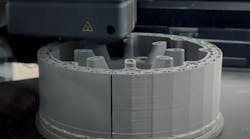3 Ways Additive Is Shaping the Factory of the Future
Additive manufacturing has long been heralded for its flexibility as a production method. More recently, additive’s ability to safeguard against global supply chain challenges has helped accelerate adoption. Its versatility has made it a leading technology for many manufacturers. In addition, additive possesses unique benefits that are complementary to sustainability and automation, which are increasingly important to manufacturers as they look to build the factory of the future.
Creating Sustainable Practices
Industrial organizations are beginning to further utilize additive manufacturing to achieve their environmental goals. Several additive manufacturing organizations have joined the Additive Manufacturer Green Trade Association (AMGTA), a global trade group created to promote the environmental benefits of additive. According to a Forrester report, companies worldwide will only increase their focus on sustainability moving forward and find ways to optimize their manufacturing processes by reducing energy consumption and waste.
Stricter European regulation and U.S. legislation are driving companies to focus on environmentally friendly production methodology. For instance, Ford and Volvo are using 3D printing across their production lines and printing components, tooling and spare parts at their facilities. Additive allows these goods to be produced on-demand, on-site, and at scale, eliminating the bulk of carbon emissions from transportation and delivery models. As we grow the scale of these applications, they could have an even bigger impact on reducing emissions in the manufacturing sector.
Furthermore, there is very little waste associated with additive. Compared to subtractive manufacturing, such as CNC machining, where materials are cut away and disposed of, additive manufacturing can reduce waste and materials costs by nearly 90% while also improving energy use by 25 to 50%. These benefits extend to the related supply chains; additive manufacturing technologies lead to more efficient production paths that help businesses lower their environmental footprints.
Supplementing the Supply Chain
Additive manufacturing can also help deliver end products to users swiftly and efficiently, boosting supply chain resiliency. COVID-19 exposed the weaknesses of companies with limited flexibility that were highly dependent on excessively optimized traditional manufacturing setups. Hospitals and medical clinics, for example, were hit hard when the pandemic impacted global supply chains, cutting off access to much-needed medical equipment and supplies. To combat the shortage, additive manufacturing was used to produce supplies on demand quickly, locally and in low to mid volumes.
On-demand 3D printing reduces the amount of capital tied up in work-in-progress and finished goods inventories, enabling manufacturing agility. Engineers can design their parts in-house and iterate as often and as quickly as needed. Local facilities can print designs on-demand from files sent across the globe or print securely from a nearby supplier.
Several companies have opened their own additive manufacturing centers, allowing them to be more agile and innovative. GM, for example, opened its new Additive Industrialization Center focused on production operations, while Lockheed Martin has an entire lab dedicated to 3D printing for R&D in its Advanced Technology Center.
Automating design innovation
There is an opportunity for design innovation thanks to the unique synergies of additive manufacturing and automation. For instance, Lockheed Martin tapped MakerBot to help develop a fully autonomous lunar rover for NASA’s Artemis program to amplify exploration on the moon. The 3D printers in its lab help with the efficiency of prototyping, getting parts out and making sure the teams can stay on schedules and budgets. Some parts, for example, were printed for prototyping and proof of concept for the rover project, including embedded systems housing, sensor mounts, and other custom parts. The engineers designed complex sensor mounts that would allow them to swap out different types of sensors, something that would have been difficult to achieve with traditional machining. In addition, since these mounts would need to be placed on top of the rover and be able to withstand extreme conditions, printing them in ABS material allowed them to test the prototypes more vigorously.
3D printing has helped NASA engineers design, develop, and test autonomous systems and processes much quicker than they could otherwise by rapidly iterating on designs for prototypes at costs 10x lower than were possible through traditional processes.
As automation becomes more prevalent to support Industry 4.0 transformation, we are seeing a deeper integration with additive manufacturing. For example, there are some 3D printing platforms that are able to do more than just 3D print parts. Some industrial systems also offer automated part removal, post processing and other tasks required along the process. These “all-in-one” type platforms can help to reduce the need for additional labor and increase the efficiency of the factory floor. But these machines can be costly and large, and are not for every application.
We are at an inflection point for global manufacturing – a point in which the burgeoning pressures to upgrade unresponsive supply chains and 20th-century energy-intensive manufacturing and transportation processes are intersecting with a maturity adoption curve for 3D printing. Over the next year and into the coming decade, we expect tremendous growth in the use of 3D printing to reduce environmental impact, ameliorate supply chain issues and generate resiliency against future shocks. However, we haven’t even scratched the surface in the evolution of the additive manufacturing industry – as AM’s synergies with transformative technologies can help to strengthen the factory of the future.
Nadav Goshen is the CEO of UltiMaker, a newly established company that merges two leading desktop 3D printing companies—Ultimaker and MakerBot. He is the former CEO of MakerBot, where he led the company’s strategic vision and was instrumental in the company's successful transformation into a leading 3D printing technology innovator. Goshen has over 10 years of experience leading turnarounds at technology companies as CEO.




